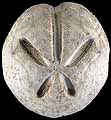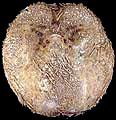The Echinoid Directory
Abatus Troschel, 1851, p. 72
[=Spatagodesma A. Agassiz, 1898, p. 83, type species S. diomedae Agassiz, 1898, p. 83 [=juvenile of Abatus cavernosus Philippi, 1845, according to Mortensen, 1951, p. 251]]
| Diagnostic Features |
|
|---|---|
| Distribution | Eocene and Recent, circum Antarctic |
| Name gender | masculine |
| Type | Spatangus (Tripylus) cavernosus Philippi, 1845, p. 435, by original designation. |
| Species Included |
|
| Classification and/or Status |
|
| Remarks |
|





